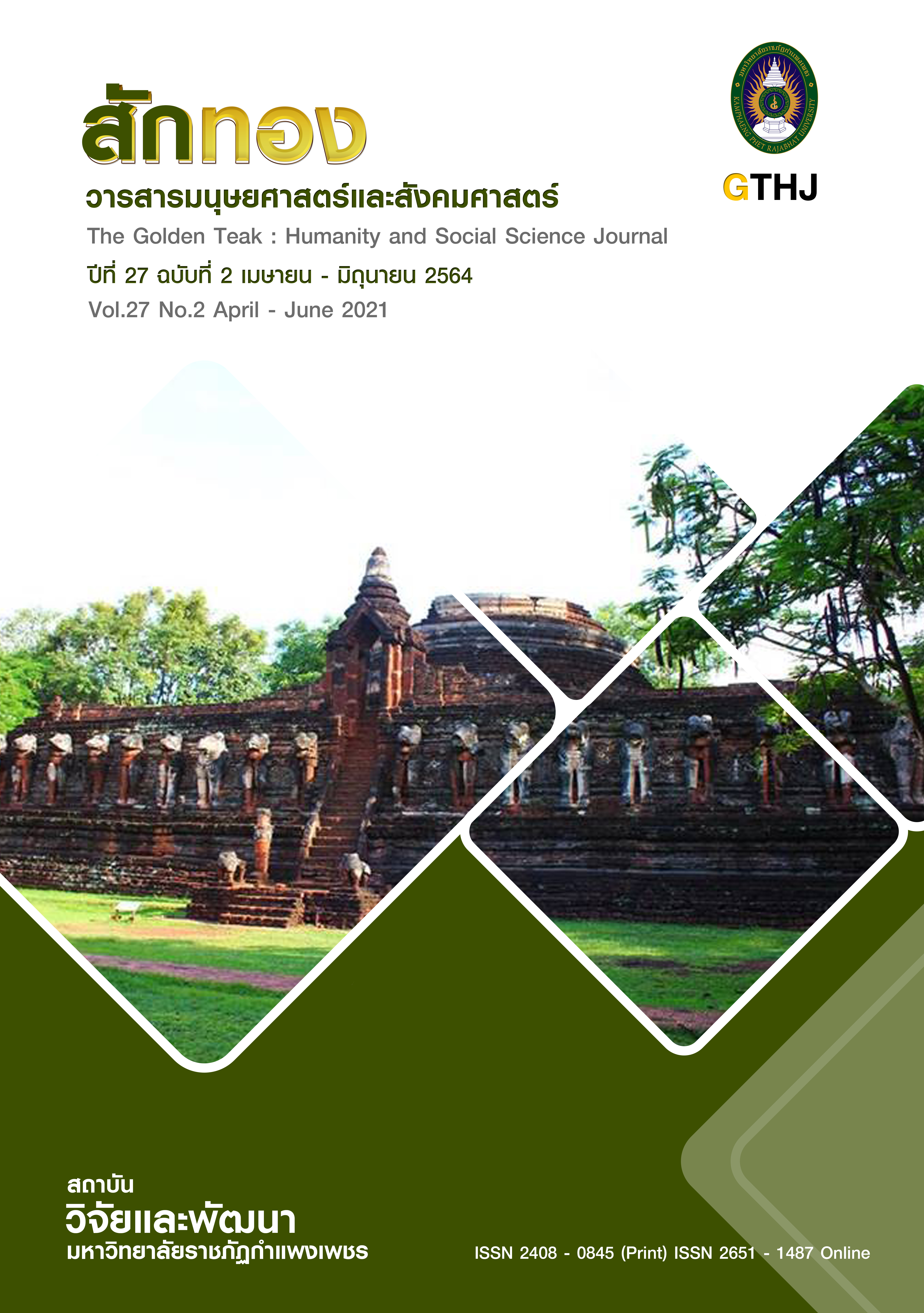ผลการจัดการเรียนรู้แบบการสอนแนะให้รู้คิดร่วมกับเทคนิคระดมสมองที่มีต่อความสามารถในการแก้ปัญหาทางคณิตศาสตร์และความคิดสร้างสรรค์ทางคณิตศาสตร์ของนักเรียน ชั้นประถมศึกษาปีที่ 5
Main Article Content
บทคัดย่อ
การวิจัยในครั้งนี้มีวัตถุประสงค์เพื่อเปรียบเทียบความสามารถในการแก้ปัญหาทางคณิตศาสตร์ของนักเรียนชั้นประถมศึกษาปีที่ 5 หลังได้รับการจัดการเรียนรู้แบบการสอนแนะให้รู้คิดร่วมกับเทคนิคระดมสมองกับเกณฑ์ร้อยละ 70 ประชากรที่ใช้ในการวิจัย คือ นักเรียนชั้นประถมศึกษาปีที่ 5 โรงเรียนวัดจันทรังษีถาวร จังหวัดปราจีนบุรี จำนวน 15 คน เครื่องมือที่ใช้ในการวิจัย ได้แก่ แผนการจัดการเรียนรู้แบบการสอนแนะให้รู้คิดร่วมกับเทคนิคระดมสมอง แบบวัดความสามารถในการแก้ปัญหาทางคณิตศาสตร์ แบบวัดความคิดสร้างสรรค์ทางคณิตศาสตร์ สถิติที่ใช้ในการวิเคราะห์ข้อมูล ได้แก่ ร้อยละ ค่าเฉลี่ย ส่วนเบี่ยงเบนมาตรฐาน และการวิเคราะห์เนื้อหา ผลการวิจัยพบว่า 1. ความสามารถในการแก้ปัญหาทางคณิตศาสตร์ของนักเรียนชั้นประถมศึกษาปีที่ 5 หลังได้รับการจัดการเรียนรู้แบบการสอนแนะให้รู้คิดร่วมกับเทคนิคระดมสมอง สูงกว่าเกณฑ์ร้อยละ 70 2. ความคิดสร้างสรรค์ทางคณิตศาสตร์ของนักเรียนชั้นประถมศึกษาปีที่ 5 หลังได้รับการจัดการเรียนรู้แบบการสอนแนะให้รู้คิดร่วมกับเทคนิคระดมสมอง สูงกว่าเกณฑ์ร้อยละ 70
Article Details
บทความที่ได้รับการตีพิมพ์เป็นลิขสิทธิ์ของวารสาร สักทอง : วารสารมนุษยศาสตร์และสังคมศาสตร์ สถาบันวิจัยและพัฒนา มหาวิทยาลับราชภัฏกำแพงเพชร
ข้อคิดเห็นใดๆ ที่ปรากฎในวารสารเป็นวรรณกรรมของผู้เขียนโดยเฉพาะ ซึ่งมหาวิทยาลัยราชภัฏกำแพงเพชรและบรรณาธิการไม่จำเป็นต้องเห็นด้วย
References
Department of Learning Management Faculty of Education, Burapha University.
_______. (2013, February-August). Development of statistical reasoning and linking ability
Mathematics to real life by using learning activities like Teaching and Thinking (CGI)
together with using High level question For grade 6. Journal of Education, 24(2),
19-22.
Arivananthan. (2015). Brain Storming Free-flowing creativity for problem-solving. New York :
UNICEF.
Carpenter, T.P. (1989). Teaching as problem solving. In R. I. Charles & E. A. Silver (Eds), The
Teaching and assessing of mathematical problem solving (pp.187-202). Reston,
VA : National Council of Teacher of Mathematics.
Carpenter, E.F., et al. (2000). Cognitively guided instruction : A research-based teacher
professional development program for elementary school mathematics :
Research report. National Center for Improving Student Learning and Achievement in
Mathematics and Science.
Franke, M. & Weishaupt, L. (1998). Using children’s thinking to teach mathematics.
UCLA Urban Education Studies Center, Connections, pp.3-7.
Guilford, J.P. (1967). The Nature of Human Intelligence. New York : McGraw Hill Book.
Intararat, W. (1997). Effects of Brainstorming Training Based on Williams Concept for
Developing ThinkingInnovation of Prathom Suksa grade 3 Phiphatana School, Bangkok. Master Thesis Master of Education, Srinakharinwirot University.
National Council of Teachers of Mathematics. (NCTM). (1989). Curriculum and evaluation
standards for school mathematics. Reston, Virginia : NCTM.
_______. (NCTM). (2000). Principles and standards for school mathematics. Reston, Virginia :
NCTM.
Osborn, A.F. (1957). Applied Imagination. New York : Charles Scribners.
Parnes, S.J. (1967). Creative Behavior Guidebook. New York : Charles Scribner, Son.
Phanmanee, A. (1997). Creativity and learning. Bangkok : Complex print
Rawlinson, J. Geoffrey. (1981). Creative Thinking and Brainstorming. England : Gower Publish.
________. (1981). Creative Thinking and Brainstorming. England : Gower Publish.
Srijaroen, P. (2009). The Effects of Brainstorming on Problem - Solving Ability in
Mathematic of Prathomsuksa VI Student at Watphoraing School in Bangkoknoi
District, Bangkok. Educational Psychology, Master of Education, Srinakharinwirot
university.
Srilasak, P. (2017, December 19). Teacher, Watchantharungsrithaworn School. Interviews.
The Institute for the Promotion of Teaching Science and Technology (IPST). (2012). Math.
(3 rd ed.). Bangkok : The Institute for the Promotion of Teaching Science and
Technology.

